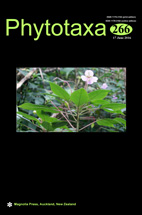Abstract
Pellaea connectens C. Chr., a cheilanthoid fern species, is rare and endemic to West Sichuan, China, and has an ambiguous taxonomical status. Recent molecular phylogenetic work has supported that it is a member of the genus Argyrochosma. In this research, we studied chromosome number and gametophyte development of this species to further elucidate its phylogenetic placement. We found that Pellaea connectens is a sexual tetraploid species with 64 spores per sporangium and with a base chromosome number of x = 27, which is consistent with Argyrochosma and different from other cheilanthoid ferns. We also found that the spore germination pattern of Pellaea connectens is of the Vittaria type and subsequent gametophyte development process is of the Ceratopteris type. All of the above concur with the characteristics of Argyrochosma nivea. Most of the gametophytes of Pellaea connectens reach an adult stage with a cordate symmetric shape, with a few developed as irregularly lobed prothalli. We conclude that cytology and gametophyte development characters support the previous taxonomic treatment of removing Pellaea connectens from Pellaea to Argyrochosma.

